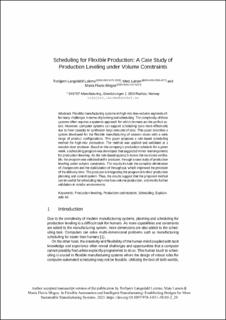Scheduling for Flexible Production: A Case Study of Production Leveling Under Volume Constraints
Peer reviewed, Journal article
Accepted version
Permanent lenke
https://hdl.handle.net/11250/3096787Utgivelsesdato
2023Metadata
Vis full innførselSamlinger
Originalversjon
Lecture Notes in Mechanical Engineering. 2023, 2, 161-168. 10.1007/978-3-031-38165-2_20Sammendrag
Flexible manufacturing systems in high-mix low-volume segments offer many challenges in terms of planning and scheduling. The complexity of these systems often requires a systemic approach for which humans are the perfect actors. However, computer systems can support scheduling tasks more effectively due to their capacity to synthesize large amounts of data. This paper describes a system developed for the flexible manufacturing of wooden doors with a wide range of product configurations. This paper proposes a rule-based scheduling method for high-mix production. The method was applied and validated at a wooden door producer. Based on the company's production schedule for a given week, a scheduling program was developed that suggested minor rearrangements for production leveling. As the rule-based approach makes the decisions verifiable, the program was validated at the producer, through a case study of production leveling under volume constraints. The results include the complete elimination of changeovers and the stabilization of throughput, which improved the precision of the delivery time. The producer is integrating the program into their production planning and control system. Thus, the results suggest that the proposed method can be useful for scheduling high-mix low-volume production, and merits further validation in similar environments.
